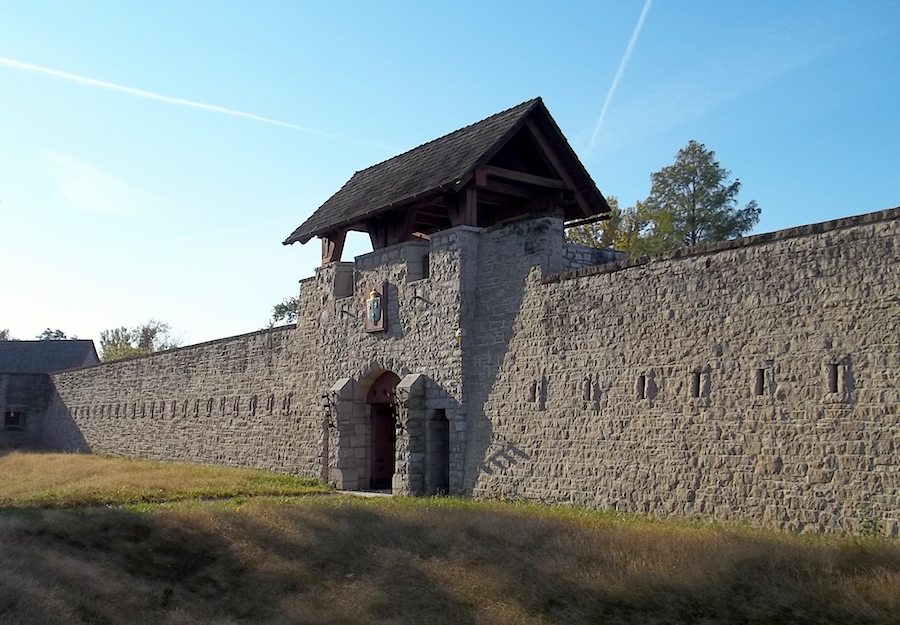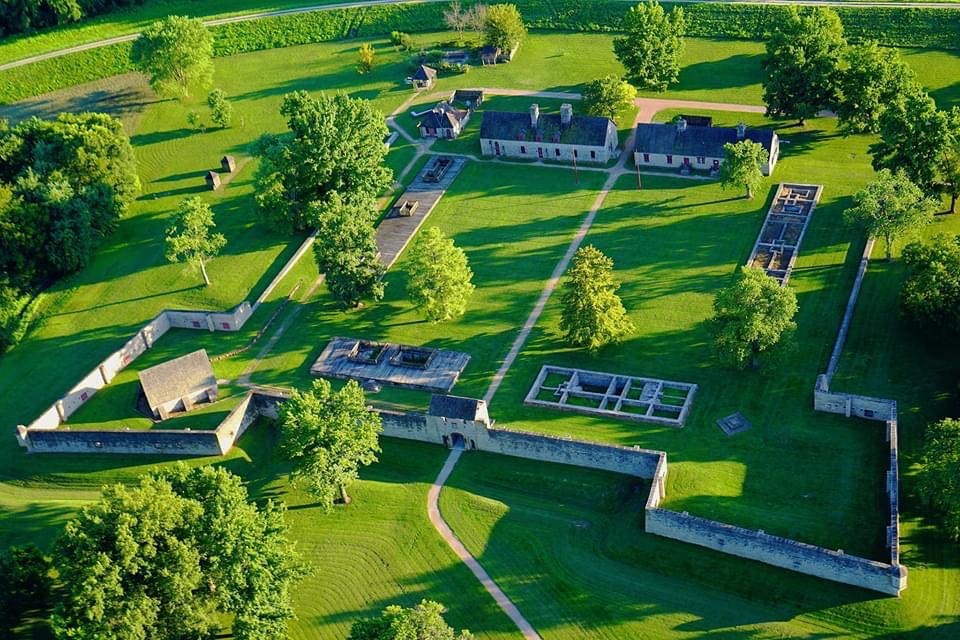
Echoes of Empire: Fort de Chartres and the Forgotten French Heart of America
Tucked away in the quiet, flood-prone lowlands of Randolph County, Illinois, a magnificent stone fort stands sentinel, a silent testament to a forgotten empire and a pivotal, yet often overlooked, chapter in American history. This is Fort de Chartres, a meticulously reconstructed bastion that once served as the administrative and military heart of the vast Illinois Country, the westernmost frontier of New France. More than just a collection of old stones, Fort de Chartres is a vibrant echo of a time when the Mississippi Valley was a strategic prize, coveted by competing European powers, and a unique blend of French culture, Native American traditions, and frontier grit flourished.
To visit Fort de Chartres today is to step back into the mid-18th century, a journey that reveals the surprising sophistication and ambition of French colonial efforts far from Quebec or New Orleans. It’s a place that challenges the dominant narrative of Anglo-American expansion, reminding us that for a significant period, a distinct French identity shaped the heartland of what would become the United States.
The Strategic Imperative: Claiming the Mississippi

The story of Fort de Chartres begins with France’s grand vision for North America. By the late 17th century, French explorers like René-Robert Cavelier, Sieur de La Salle, had navigated the entire length of the Mississippi River, claiming its vast watershed for King Louis XIV. This immense territory, stretching from the Great Lakes to the Gulf of Mexico, was intended to link French Canada (New France) with the newly established colony of Louisiana. The Illinois Country, a fertile crescent nestled between the Mississippi and Kaskaskia Rivers, was the critical linchpin in this grand design.
"The Illinois Country was strategically vital," explains Dr. Robert Moore, a historian specializing in French colonial America. "It wasn’t just about furs; it was about controlling the riverine network, forging alliances with Native American nations like the Kaskaskia, Peoria, and Cahokia, and establishing a powerful presence to counter the ever-encroaching British from the east."
The region quickly became known as the "breadbasket of New France" due to its rich agricultural lands, which produced surplus grains and foodstuffs to supply other French outposts, including New Orleans. French settlers, often retired soldiers or adventurous farmers, established villages like Kaskaskia, Cahokia, and Prairie du Rocher, cultivating a unique blend of French customs, language, and close ties with their Native American neighbors.
From Wood to Stone: The Evolution of Fort de Chartres
The need for a strong military presence to protect this burgeoning colony became evident. The first Fort de Chartres, a hastily constructed wooden palisade, was built in 1720 by Pierre Dugué de Boisbriant. Located about 18 miles north of Kaskaskia, its primary purpose was to secure French claims and serve as a base for controlling the fur trade and maintaining alliances. However, like many early frontier forts, it was vulnerable to the elements and lacked the grandeur befitting a regional capital.
A second wooden fort, built around 1725, replaced the first, moving slightly inland to avoid the persistent flooding of the Mississippi River. While an improvement, it still wasn’t the enduring symbol of imperial power that Paris envisioned. The French court, concerned by growing British influence in the Ohio Valley and the increasing value of the Illinois Country, decided to make a definitive statement.
Between 1753 and 1760, at a staggering cost estimated to be equivalent to tens of millions of dollars in today’s currency, the third and final Fort de Chartres was constructed. This was no ordinary frontier outpost. Built entirely of cut limestone, quarried from nearby bluffs, it was a massive, star-shaped structure with bastions at each corner, a deep moat, and walls reportedly up to 15 feet high and 3 feet thick. It encompassed over four acres within its walls, boasting a large stone magazine, barracks for soldiers, a chapel, a guardhouse, and a commandant’s house.
"It was hailed as the ‘Versailles of the West’," says Sarah Jenkins, site superintendent at Fort de Chartres State Historic Site, "and for good reason. Its scale and construction were unparalleled on the North American frontier. It wasn’t just a fort; it was a symbol of French imperial ambition, designed to project power and permanence in the heart of the continent."

Life Within the Walls: A Microcosm of French Colonialism
Life at Fort de Chartres was a vibrant tapestry woven from military discipline, civilian commerce, and cultural exchange. The garrison typically consisted of French marines, or Troupes de la Marine, commanded by officers appointed by the crown. Their duties included maintaining order, defending against potential incursions, and participating in patrols to assert French sovereignty.
Beyond the military, the fort served as a bustling administrative and commercial hub. Merchants and traders, known as voyageurs and coureurs des bois, brought in goods from New Orleans and Montreal, exchanging them for furs with Native American partners. Artisans—blacksmiths, carpenters, and coopers—plied their trades within or just outside the fort’s walls. Families of soldiers and civilians lived in the nearby villages or sometimes within the fort itself, creating a small, self-sufficient community.
French culture thrived. The Catholic faith was central, with a resident priest ministering to the spiritual needs of the community. French was the lingua franca, and traditions from the homeland, adapted to the frontier environment, were maintained. Feasts, dances, and celebrations marked the calendar, often involving Native American allies, whose presence was a constant reminder of the complex intercultural relationships that defined the Illinois Country. Intermarriage between French settlers and Native Americans was not uncommon, further blurring cultural lines and creating unique creole communities.
The Tide Turns: British Occupation and French Exodus
The grandeur of Fort de Chartres, however, was tragically short-lived. Even as its stone walls rose, the geopolitical landscape of North America was shifting dramatically. The French and Indian War (1754-1763), known globally as the Seven Years’ War, pitted France against Great Britain for control of the continent. Despite their strategic fort, the French ultimately lost.
The Treaty of Paris in 1763 officially ended the war, ceding all French territory east of the Mississippi River to Great Britain. This meant the mighty Fort de Chartres, the "Versailles of the West," was to be handed over to its former enemies.
The British takeover was not a smooth transition. Many French residents, fiercely loyal to their king and their culture, refused to live under British rule. A significant number moved across the Mississippi River to Spanish Louisiana (which included lands west of the river), establishing new communities like Ste. Genevieve and St. Louis, where they could maintain their language and traditions.
On October 10, 1765, Captain Thomas Stirling, leading a detachment of the 42nd Royal Highland Regiment (the "Black Watch"), formally took possession of Fort de Chartres. It was a somber day for the remaining French inhabitants, marking the official end of New France’s presence in the Illinois Country.
The British occupation, ironically, was also brief. The very river that had been the lifeblood of the fort proved to be its undoing. The Mississippi River, notorious for its shifting course and powerful floods, began to erode the fort’s western wall. By 1772, the British, deeming the fort indefensible against the encroaching river, abandoned it and moved their garrison to Kaskaskia. Fort de Chartres, less than two decades after its completion, was left to the mercy of nature and the passage of time.
From Ruin to Restoration: A Legacy Reclaimed
For over a century and a half, Fort de Chartres slowly succumbed to ruin. Its valuable cut stone was scavenged by local settlers for other construction projects. Its walls crumbled, and the site became overgrown, a silent mound of earth and debris swallowed by the encroaching forest. Its memory faded, known only to a handful of local historians and dedicated archaeologists.
The early 20th century saw a growing interest in preserving American historical sites, and Fort de Chartres, with its unique French heritage, began to attract attention. Initial efforts at preservation and limited reconstruction began in the 1910s and 1920s. However, it was during the 1930s, under the Civilian Conservation Corps (CCC) and later with significant archaeological and historical research, that a comprehensive plan for reconstruction took shape.
Today, the Fort de Chartres State Historic Site is one of the most impressive historical reconstructions in the United States. While not every building has been rebuilt to its original specifications (the commandant’s house, for example, is a modern interpretation), the massive stone walls, the impressive powder magazine (the only original 18th-century structure still standing), the barracks, and the guardhouse have been meticulously recreated. The site stands as a living museum, offering visitors a tangible connection to the past.
Visiting Fort de Chartres: Stepping Through Time
To walk the grounds of Fort de Chartres today is to experience a profound sense of history. The sheer scale of the stone walls immediately impresses, hinting at the monumental effort required to build such a structure in the wilderness. Inside, the quiet courtyards and reconstructed buildings evoke images of soldiers drilling, merchants haggling, and families living their daily lives under the French flag.
The fort comes alive most vividly during its special events. The annual Fort de Chartres Rendezvous, held every June, is one of the largest and oldest living history events in the Midwest. Thousands of reenactors, dressed in authentic 18th-century attire, gather to recreate the vibrant atmosphere of the French colonial era. There are musket and cannon firing demonstrations, craftspeople demonstrating period skills, traditional music and dancing, and Native American encampments, all contributing to an immersive experience that transports visitors back to the frontier. Other events, like the Winter Rendezvous and various military encampments, further enrich the visitor’s understanding.
"Fort de Chartres is more than just a historical site; it’s a cultural anchor," notes a local resident attending the Rendezvous. "It reminds us that Illinois has deep French roots, a legacy that’s often overshadowed but deserves to be celebrated and remembered."
In a nation often defined by its Anglo-American origins, Fort de Chartres serves as a vital counter-narrative, a powerful reminder of the diverse forces that shaped the North American continent. It stands as a testament to French imperial ambition, the resilience of frontier life, and the enduring power of history to inform and inspire. It is a place where the echoes of empire still resonate, inviting all who visit to listen closely to the forgotten French heart of America.


